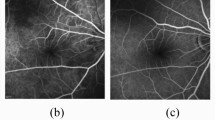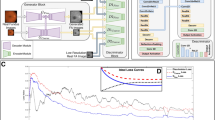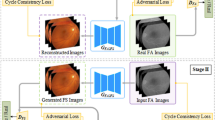Abstract
Fundus fluorescein angiography (FA) is an indispensable procedure that can investigate the integrity of retina vasculature. Fluorescein angiograms progress through five phases: pre-arterial, arterial, arteriovenous, venous, and late, and each phase could be an important diagnostic basis for retina-related disease. However, the FA imaging technique may provide risks of harm to the patients. To help physicians reduce the potential risks of diagnosis, we proposed “SequenceGAN”, a novel sequential generative adversarial network that aims to generate FA sequences of critical phases from a structure fundus image. Moreover, a feature-space loss is applied to ensure the generated FA sequences with a better visual effect. The proposed method was qualitatively and quantitatively compared with existing FA image generation methods and image translation methods. The experimental results indicate that the proposed model has better performance on the generation of retina vascular, leakage structures, and characteristics of each angiogram phase, and thus indicates potential value for application in clinical diagnosis.
Access this chapter
Tax calculation will be finalised at checkout
Purchases are for personal use only
Similar content being viewed by others
References
Li, W.: Generating fundus fluorescence angiography images from structure fundus images using generative adversarial networks. Proc. Mach. Learn. Res. 121, 1–16 (2020)
O’Toole, L.: Fluorescein and ICG angiograms: still a gold standard. Acta Ophthalmol. Scand. 85 (2007)
Dolan, B.J.: Fluorescein and ICG angiography textbook and atlas. Optom. Vis. Sci. 76, 520 (1999)
Varma, D.D., Cugati, S., Lee, A.W., Chen, C.S.: A review of central retinal artery occlusion: clinical presentation and management. Eye 27, 688–697 (2013)
Wong, T.Y., Scott, I.U.: Retinal-vein occlusion. N. Engl. J. Med. 363, 2135–2144 (2010)
Yannuzzi, L.A., et al.: Fluorescein angiography complication survey. Ophthalmology 93, 611–617 (1986)
Musa, F., Muen, W.J., Hancock, R.: Adverse effects of fluorescein angiography in hypertensive and elderly patients. Acta Ophthalmol. Scand. 84, 740–742 (2006)
Isola, P.: Image-to-image translation with conditional adversarial networks. In: Proceedings of the IEEE Conference on Computer Vision and Pattern Recognition. CVPR (2017)
Zhu, J.Y., Park, T., Isola, P., Efros, A.A.: Unpaired image-to-image translation using cycle-consistent adversarial networks. In: Proceedings of the IEEE International Conference on Computer Vision (2017)
Zhu, J.: Toward multimodal image-to-image translation. In: Proceedings of the 31st International Conference on Neural Information Processing Systems, pp.465–476 (2017)
Choi, Y., Choi, M., Kim, M., Ha, J.W., Kim, S., Choo, J.: StarGAN: unified generative adversarial networks for multi-domain image-to-image translation. In: Proceedings of the IEEE Computer Society Conference on Computer Vision and Pattern Recognition (2018)
Schiffers, F., Yu, Z., Arguin, S., Maier, A., Ren, Q.: Synthetic fundus fluorescein angiography using deep neural networks. In: Maier, A., Deserno, T., Handels, H., Maier-Hein, K., Palm, C., Tolxdorff, T. (eds.) Bildverarbeitung für die Medizin 2018. Informatik aktuell, pp. 234–238. Springer, Heidelberg (2018). https://doi.org/10.1007/978-3-662-56537-7_64
Hervella, Á.S.: Deep multimodal reconstruction of retinal images using paired or unpaired data. In: International Joint Conference on Neural Networks (IJCNN), pp. 1–8. IEEE (2019)
Li, K., Yu, L., Wang, S., Heng, P.-A.: Unsupervised retina image synthesis via disentangled representation learning. In: Burgos, N., Gooya, A., Svoboda, D. (eds.) SASHIMI 2019. LNCS, vol. 11827, pp. 32–41. Springer, Cham (2019). https://doi.org/10.1007/978-3-030-32778-1_4
Hervella, Á.S., Rouco, J., Novo, J., Ortega, M.: Retinal image understanding emerges from self-supervised multimodal reconstruction. In: Frangi, A.F., Schnabel, J.A., Davatzikos, C., Alberola-López, C., Fichtinger, G. (eds.) MICCAI 2018. LNCS, vol. 11070, pp. 321–328. Springer, Cham (2018). https://doi.org/10.1007/978-3-030-00928-1_37
Kamran, S.A., Fariha Hossain, K., Tavakkoli, A., Zuckerbrod, S., Baker, S.A., Sanders, K.M.: Fundus2Angio: a conditional GAN architecture for generating fluorescein angiography images from retinal fundus photography. In: Bebis, G., et al. (eds.) ISVC 2020. LNCS, vol. 12510, pp. 125–138. Springer, Cham (2020). https://doi.org/10.1007/978-3-030-64559-5_10
Johnson, J., Alahi, A., Fei-Fei, L.: Perceptual losses for real-time style transfer and super-resolution. In: Leibe, B., Matas, J., Sebe, N., Welling, M. (eds.) ECCV 2016. LNCS, vol. 9906, pp. 694–711. Springer, Cham (2016). https://doi.org/10.1007/978-3-319-46475-6_43
Zhang, R., Isola, P., Efros, A.A., Shechtman, E., Wang, O.: The unreasonable effectiveness of deep features as a perceptual metric. In: Proceedings of the IEEE Conference on Computer Vision and Pattern Recognition, pp. 586–595 (2018)
Acknowledgement
This work is supported by the National Key Research and Development Program of China (2016YFF0102002) and the National Natural Science Foundation of China (61605210, 62075235).
Author information
Authors and Affiliations
Editor information
Editors and Affiliations
Rights and permissions
Copyright information
© 2021 Springer Nature Switzerland AG
About this paper
Cite this paper
Li, W. et al. (2021). SequenceGAN: Generating Fundus Fluorescence Angiography Sequences from Structure Fundus Image. In: Svoboda, D., Burgos, N., Wolterink, J.M., Zhao, C. (eds) Simulation and Synthesis in Medical Imaging. SASHIMI 2021. Lecture Notes in Computer Science(), vol 12965. Springer, Cham. https://doi.org/10.1007/978-3-030-87592-3_11
Download citation
DOI: https://doi.org/10.1007/978-3-030-87592-3_11
Published:
Publisher Name: Springer, Cham
Print ISBN: 978-3-030-87591-6
Online ISBN: 978-3-030-87592-3
eBook Packages: Computer ScienceComputer Science (R0)





